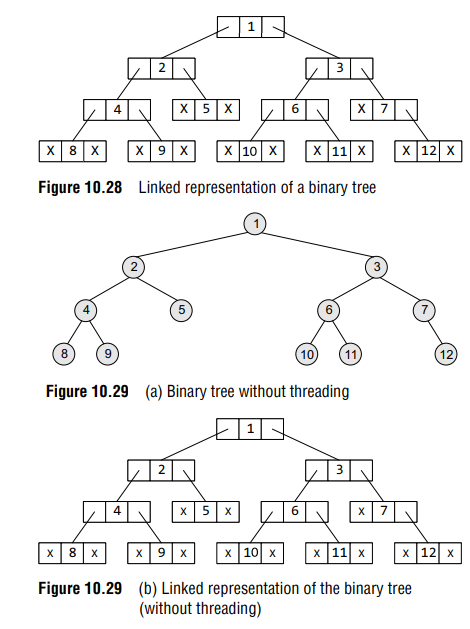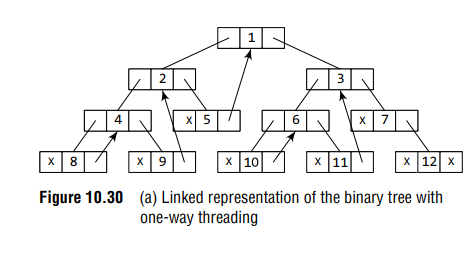A threaded binary tree is the same as that of a binary tree but with a difference in storing the NULL pointers. Consider the linked representation of a binary tree as given in Fig. 10.28.
In the linked representation, a number of nodes contain a NULL pointer, either in their left or right fields or in both. This space that is wasted in storing a NULL pointer can be efficiently used to store some other useful piece of information. For example, the NULL entries can be replaced to store a pointer to the in-order predecessor or the in-order successor of the node. These special pointers are called threads and binary trees containing threads are called threaded trees. In the linked representation of a threaded binary tree, threads will be denoted using arrows. There are many ways of threading a binary tree and each type may vary according to the way the tree is traversed

In one-way threading, a thread will appear either in the right field or the left field of the node. A one-way threaded tree is also called a single-threaded tree. If the thread appears in the left field, then the left field will be made to point to the in-order predecessor of the node. Such a one-way threaded tree is called a left-threaded binary tree. On the contrary, if the thread appears in the right field, then it will point to the in-order successor of the node. Such a one-way threaded tree is called a right threaded binary tree
In a two-way threaded tree, also called a double-threaded tree, threads will appear in both the left and the right field of the node. While the left field will point to the in-order predecessor of the node, the right field will point to its successor. A two-way threaded binary tree is also called a fully threaded binary tree. Figure 10.29 shows a binary tree without threading and its corresponding linked representation. The in-order traversal of the tree is given as 8, 4, 9, 2, 5, 1, 10, 6, 11, 3, 7, 12
One-way Threading
Figure 10.30 shows a binary tree with one way threading and its corresponding linked representation
Node 5 contains a NULL pointer in its RIGHT field, so it will be replaced to point to node 1, which is its in-order successor. Similarly, the RIGHT field of node 8 will point to node 4, the RIGHT field of node 9 will point to node 2, the RIGHT field of node 10 will point to node 6, the RIGHT field of node 11 will point to node 3, and the RIGHT field of node 12 will contain NULL because it has no in-order successor


Two-way Threading
Figure 10.31 shows a binary tree with two-way threading and its corresponding linked representation.
Node 5 contains a NULL pointer in its LEFT field, so it will be replaced to point to node 2, which is its in-order predecessor. Similarly, the LEFT field of node 8 will contain NULL because it has no in-order predecessor, the LEFT field of node 7 will point to node 3, the LEFT field of node 9 will point to node 4, the LEFT field of node 10 will point to node 1, the LEFT field of node 11 will contain 6, and the LEFT field of node 12 will point to node 7.

